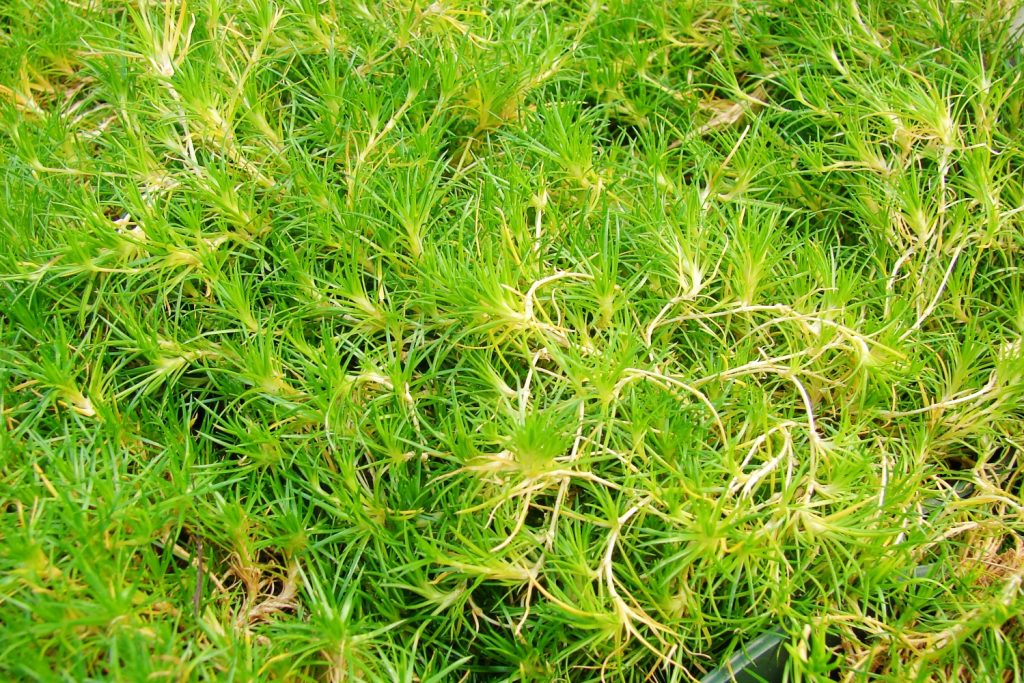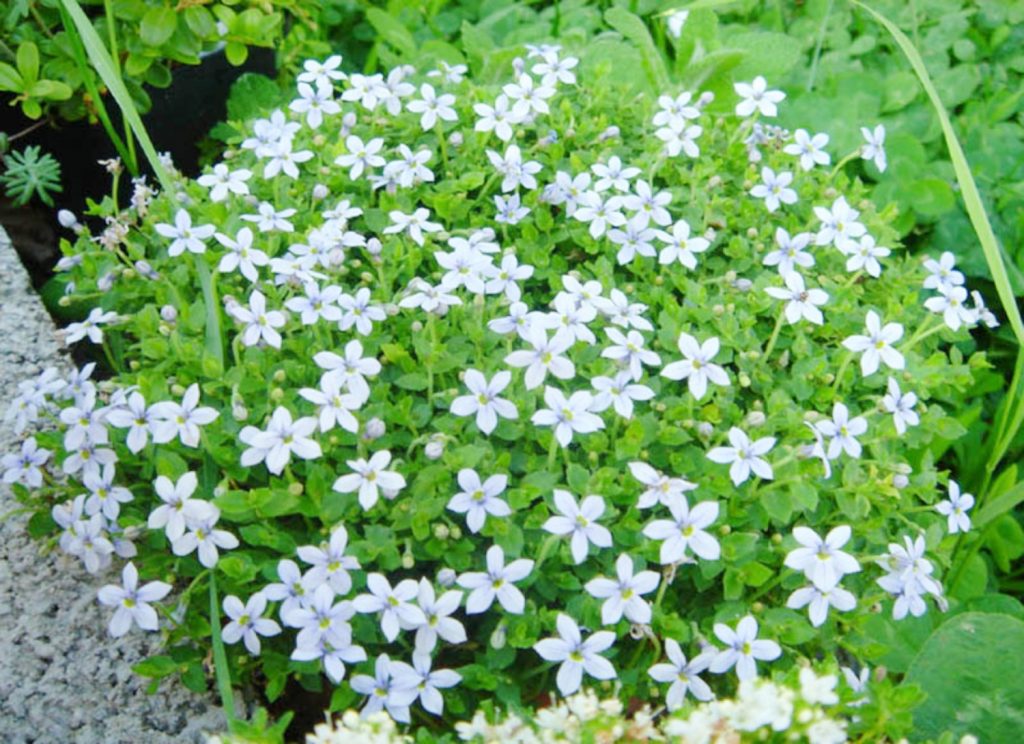

We’re here to help! Wild Yards is a completely free website that is 100% dedicated to helping you create a wildlife-friendly, sustainable yard. Read more
WildYards is reader-supported. When you buy a product through a link on our site, we may earn a comission. Every product is independently selected by our (obsessive) editors and our reviews are unbiased and objective. Read more about our mission or our privacy policy.
You didn’t spend hours laying down pavers only to see your new walking path carpeted with weeds. You’ve got to fill the spaces in between those pavers before unwanted plants get a chance to sprout. Gravel is one option, but it can get pricey quickly, especially if you have multiple walkways to fill in. Fortunately, gravel isn’t the only choice available. Consider using one of these low-maintenance ground cover plants to grow between the pavers, so weeds don’t take over and ruin all of your hard work.
Irish moss, mind-your-own-business, and creeping mazus are ideal for shady garden paths, and easily fill in between pavers. For sunnier yards, try creeping Jenny, creeping thyme, and blue star creeper, which all produce fragrant flowers that attract pollinators.
9 Ground cover plants for between pavers and stone walkways
The spaces between the stones and pavers in your walkways can be a challenge to deal with. Leaving them untouched allows weeds to pop up. It also makes it easier for dirt and mud to wash over the stones and pavers, making everything a mess. Add some fresh greenery to your garden and keep pesky weeds at bay with the help of these 9 ground covers, which are perfect for filling in between pavers.
Irish Moss
Hardy from zones 4 through 9, Irish moss grows best in full to partial shade, especially when planted in moist soils. This fuzzy, low-growing moss can stand up to light foot traffic, which makes it a good ground cover plant for between pavers. It’s the perfect choice for forested landscapes and gives any garden a whimsical feel.
Irish moss is also a great option for minimalistic and modern landscapes. This ground cover’s vibrant color can be used to create a dramatic effect. Yet, it also looks at home in a zen garden, thanks to its soothing, lush appearance. Irish moss is a slow-growing ground cover that can take several years to fill in between your pavers. Plants grow 1 to 2 inches tall maximum and can spread upwards of a foot.

Creeping Mazus
For gardens in zones 5 through 8, consider growing creeping mazus. This is another shade-tolerant ground cover for planting between pavers. Creeping mazus grows 2 inches tall at the most, and can spread up to a foot. Plants flower in spring and summer, producing dozens of tiny purple flowers. The blooms are great for attracting pollinators, and plants can be pruned back after the flowering period to encourage dense growth.
Creeping mazus can handle low to moderate foot traffic, and grows best in moist yet well-draining soils that are rich in organic materials. There’s no need to fertilize this ground cover, as it has low nutrient needs, however, if your garden has sandy soil, consider adding some homemade compost to the mix before planting.

Mind-Your-Own-Business
Also known as baby’s tears, the hilariously named mind-your-own-business is a low-growing ground cover that maxes out at 2 inches tall, making it an excellent option for growing between pavers. Native to the Mediterranean region, mind-your-own-business is hardy from zones 9 through 11 and thrives in full to partial shade when planted in moist, well-draining soil.
If you want to fill in the spaces between your pavers ASAP, then mind-your-own-business can help. This fast-growing ground cover can reach full coverage in a few short months, as long as all of the plant’s growing conditions are met. Regular pruning prevents the plants from becoming leggy so they can produce dense carpet-like growth. Mind-your-own-business is tolerant of light to moderate foot traffic, but heavy foot traffic can crush its foliage.

Creeping Thyme
Hardy from zones 4 through 9, creeping thyme is an incredibly versatile ground cover that can be grown in even the sandiest and rockiest of soils. Creeping thyme has low water requirements, and thrives in full sun, where it quickly reaches its maximum size of 2 to 4 inches tall. Healthy plants can spread an impressive 18 feet!
Creeping thyme is fast-growing, so much so that many gardeners consider it to be invasive. Fortunately, these plants are easy to rein in. Just remove wayward vines when you come across them. You can even use the cuttings to start new plants. Regular pruning, especially after the flowering period in mid to late summer, helps plants produce thick, carpet-like growth that can easily stand up to daily foot traffic.
Blue Star Creeper
Maybe you don’t have a shady backyard. If your garden gets full to partial sun, then blue star creeper would be a better choice of ground cover. This fast-growing, low-maintenance plant is tolerant of moderate to heavy foot traffic. When all of the plant’s growing requirements are met, it can reach its maximum size of 3 inches tall by 2 feet wide within a matter of months.
As its name suggests, blue star creeper produces blue, star-shaped flowers from spring to summer. Plants can be trimmed back after the blooming period, and doing so can help them fill in more quickly to suppress weeds. Blue star creeper’s flowers are fragrant and showy, perfect for adding a dash of color to your walkways.

White Diamond Stronecrop
White diamond stonecrop is relatively slow-growing, so it can take several seasons for this plant to fill in between pavers. However, it is more tolerant of dry soils than most other ground covers, which makes it well-suited to sandy soils and arid climates. This plant is tolerant of low foot traffic, but, as a succulent, it’s a perfect choice for southwest-style landscapes.
White diamond stonecrop can be grown from zones 3 through 9. At maturity, plants reach 4 to 6 inches tall and can spread up to a foot. Plants produce small star-shaped flowers in late summer in shades of white and pink. The flowers are very attractive to bees so consider growing this plant between pavers in your garden if you want to bring more pollinators to your backyard.
Dwarf Mondo Grass
Dwarf mondo grass isn’t picky. It can grow just as well in sandy and clay-rich soils as it can in loamy ones. Its versatility, coupled with its low water needs and tolerance of full sunlight, make it a popular ground cover plant for between pavers. This plant can stand up to light to moderate foot traffic, so it’s a good choice for the less-frequented areas of your garden.
Dwarf mondo grass can be grown in zones 6 through 11 and reaches 2 to 4 inches tall at maturity. Plants are slow-growing, so it may take several years before they fill in. However, dwarf mondo grass is extremely tolerant of humid conditions. If you’re looking for a ground cover for a poorly ventilated area, dwarf mondo grass can grow there without missing a beat.

Corsican Mint
Like all other varieties of mint, Corsican mint is incredibly fast-growing when planted in moist, fertile, well-draining soils. But one thing that Corsican mint doesn’t have in common with other mint varieties is that it can tolerate full sun. When it receives 4 to 6 hours of direct sunlight per day, this plant can fill in between pavers within a single season.
Corsican mint is hardy from zones 6 through 9. Plants produce pink and purple flowers in summer, which are a hit with bees, especially honeybees, who will go out of their way to collect pollen and nectar from the blossoms. Overall, Corsican mint is a sturdy ground cover that can stand up to heavy foot traffic. It reaches 1 to 2 inches tall at maturity and spreads about a foot wide. Plants are easy to propagate from cuttings, so consider starting new ones to create a border for the flower beds around the foundation of your home.
Creeping Jenny
Creeping Jenny is a delightful ground cover that grows effortlessly when planted in well-draining soil and in full to partial sunlight. This ground cover is often grown in hanging baskets, but it’s a popular choice for filling in between pavers, too, thanks to its handsome foliage and long blooming period — its flowers can last up to a month!
Creeping Jenny is a stout plant that can tolerate moderate to heavy foot traffic. Its vibrant green foliage and cheery yellow flowers are perfect for adding some color to your stone walkways. Plants grow 2 to 4 inches tall and can spread up to 2 feet wide in ideal conditions. This ground cover is hardy from zones 3 through 9. Its informal appearance makes it an excellent choice for cottage and farmhouse-style landscapes.

Tips for choosing the right ground cover
Keep your space in mind when deciding on a ground cover. Choose plants that will suit your garden’s soil and light conditions, and be sure to keep the plants well-watered in the weeks following transplanting, to help the roots get established. Slow-growing varieties work best for small spaces, while fast-growing ground covers are more suitable for large areas.
Be sure to keep foot traffic in mind when choosing a ground cover as well. Delicate ground covers, like Irish moss and mind-your-own-business, aren’t strong enough to survive being walked on day after day. But creeping thyme and Corsican mint can easily withstand regular wear and tear.
Planting the right ground cover plants between pavers in your garden helps prevent weeds and erosion, all while adding color and texture to the space. Consider adding one or more of these gorgeous ground covers to your backyard to add the finishing touches to your stone walkways.
